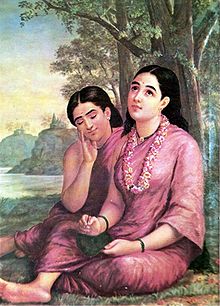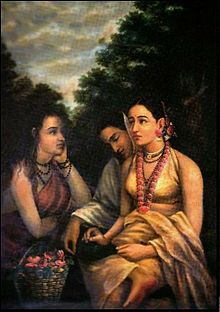Abhijnanashakuntala

Abhijnanashakuntala ( Sanskrit : अभिज्ञानशाकुन्तल Abhijñānaśākuntala "Recognition of Shakuntala"), often Shakuntala for short, is a play in seven acts by the Indian poet Kalidasa . In a book by the Mahabharata, he discovered the ancient story of the beautiful Shakuntala, mother of King Bharata, and wrotethe verse drama, inspired by the epic representation from Hindu mythology. The play is written in a mixture of Sanskrit and Prakrit and is considered the national drama of Indian theater.
history
The epic of Mahabharata tells the story of King Dushyanta, who falls in love with Shakuntala, a girl from an ascetic hermitage. While hunting for a gazelle, the young king comes across a hermitage in the middle of the forest, where pious ascetics serve the gods.
Her oldest is Kanva, whose supposed daughter Shakuntala can be observed by the king unnoticed. Her beauty appeals to him. He introduces himself to her and her friends as scholars at the royal court and learns that Shakuntala is only Kanva's foster daughter. Her real father is a saint, her mother even a girl of gods, an elf. The girl, too, feels drawn to the stranger, but neither of them dares to show his love for the other or even to confess. The king breaks off the hunt so as not to disturb the peace and quiet of the pious hermitage. Then the hermits ask him to take over the protection of the hermitage against evil demons for a few days. The king happily agrees, as he can so unobtrusively approach his beloved again.
Shakuntala is feverish, because the glow of love has awakened in her too. The king discovers himself and makes her his wife. But then his duties call him back to court. When he parted, he gave his wife a ring and promised to have her come soon. Shakuntala is so filled with thinking about the Beloved that she inadvertently fails to pay due honor to one of the priests. Without her knowledge, the latter pronounces a curse on her, which becomes a terrible reality for her: the beloved man will forget her as soon as she loses her wedding ring.
Kanva sends the pregnant foster daughter with an entourage to the capital of the king's palace. Shakuntala says goodbye to everything that is dear to her and is familiar. When she appears before the king, he does not recognize her and treats her like a deceiver. Confused, she wants to show him the ring, but she lost it while washing in the river. As a mercy she is allowed to stay in the royal court until her child is born, but then she is kidnapped by an elf into the forest wilderness.
Soon after, a fisherman who put the king's ring up for sale is arrested. He claims to have found it in the stomach of a fish. When the king sees this ring, he immediately remembers the beloved. Repentance and pain seize him. From memory he himself paints a picture of his beloved, at the sight of which he gives himself up to despair. Then the god Indra asks him through a messenger to help him in the fight against evil giants. The king, who wants to atone for the guilt towards his beloved wife, defeats the enemies of God. As a reward he is allowed to visit Kashyapa , the father of the gods , a grace that only a few mortals receive. There he meets the son Shakuntala has given birth to him in the meantime, a handsome, brave and clever boy who bears the mark of the future world ruler. The two spouses meet again as mature and purified people. With the blessing of Kasyapa they return to the kingdom of the king. At the end, Dushyanta praises fate: “The blossom is followed by the fruit, the clouds by the rain. First the cause and then the effect. ”The king asks Lord Shiva to free him from the fetters of being in the future.
development
Kalidasa designed his verse drama in the fourth century AD for the caste society of Indian theater. The play became the national drama of the Indians. During the Classical period, the English scholar William Jones first translated it from Indian Sanskrit into English in 1789 . In 1790 Georg Forster translated the English edition into German prose. In his early years Johann Wolfgang von Goethe praised Kalisada's oriental poetry, which he himself would have liked to have composed in German. In addition, the play probably inspired him for his “Prelude to the Theater” in Faust. A tragedy.
Artistic adaptations of the material
- Rolf Lauckner published a revision in 1924
- Camille Claudel created a sculpture Shakuntala .
- Franz Schubert wrote an unfinished opera in 1820 with the title Sacontala . The opera was supplemented by Fritz Racek and premiered in 1971. After Thomas Aigner's rediscovery of the complete libretto in 2002 , Karl Aage Rasmussen created another reconstruction, which was premiered in 2006 in concert and in 2010 in scenic form. Franco Alfano (who completed Giacomo Puccini's opera Turandot ) wrote an opera "Sakuntala". Karl Goldmark wrote an overture "Sakuntala".
literature
- Kalidasa: Sakuntala; Drama in seven acts. (Introduction, translation from Sanskrit and Prakrit and comments by Albertine Trutmann) Ammann Verlag, Vienna 2006;
- Sakuntala. Drama in seven acts. Introduction, translation from Sanskrit and Prakrit and notes by Albertine Trutmann. Ammann, Zurich 2004. ISBN 3-250-10465-5
- Sakuntala, a play by Kalidasa, translated and edited. by Ernst Heinrich Meier, Stuttgart 1852 ( digitized version )
- Johannes Mehlig, Reclam, Leipzig 1983. (Translation of the three dramas and the two poems Meghaduta and Ritusamhara)
- Miller, BS, The Theater of Memory (1984); studies by MB Harris (1936) and K. Krishnamoorthy (1972).
- Theater of Memory: The Plays of Kalidasa. Trans. V. Barbara Stoller Miller, Edwin Gerow, David Gitomer. Columbia University Press, 1984 ( UNESCO Collection of Representative Works : European). ISBN 0-231-05838-1
- Kalidasa: Sakuntala or the decisive ring . Scaneg, Munich 1987, ISBN 978-3-89235-303-4 .
- Dorothy Matilda Figueira: Translating the Orient: The Reception of "Śākuntala" in Nineteenth-Century Europe . State University of New York Press, Albany 1991, ISBN 0-7914-0327-0 (study of various German and French translations of the Sakuntala).
Individual evidence
- ↑ cf. Erich Trunz (Ed.): Goethe, Faust. Munich 1986, p. 507
- ↑ Camille Claudel working on Shakuntala ( memento from September 7, 2012 in the web archive archive.today ), accessed on July 13, 2018
- ^ New Schubert edition - Schubert database . Archived from the original on December 24, 2013.
- ↑ Multimedia revue instead of exotic fairy tales: Schubert's “Sakontala” in Saarbrücken. In: Neue Musikzeitung April 1, 2010, accessed November 14, 2012
Web links
- Original text ( memento from November 10, 2010 in the Internet Archive ) in transliteration on GRETIL (Göttingen Register of Electronic Texts in Indian Languages)
